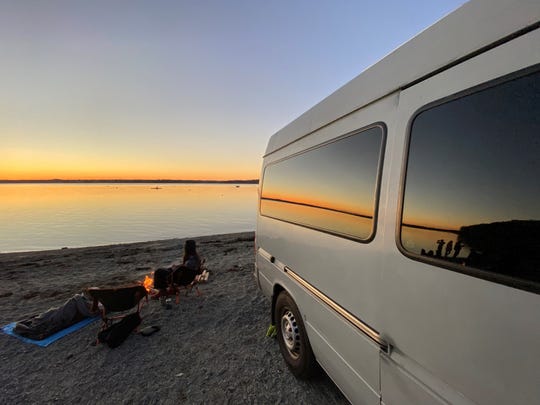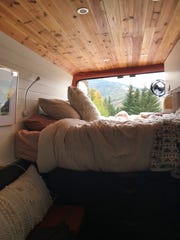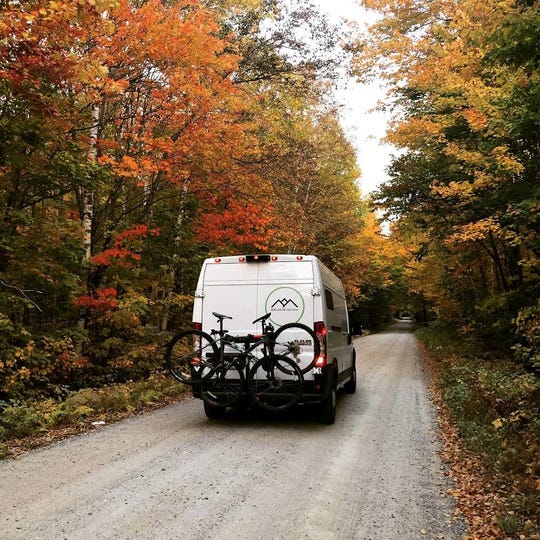Van life may sound exciting, but it takes a lot of strategy and planning to make it work.
USA TODAY
Several months into the pandemic, married couple JennaLynn and Corey Self were growing increasingly frustrated with their life in their cramped apartment near Capitol Hill in Washington, D.C.
It was expensive, and efforts to practice social distancing in a big city during COVID-19 felt increasingly fraught.
“We were just incredibly restless,” JennaLynn says. “If every day we wake up in our small apartment in D.C. and we walk our dog around the block and that’s the extent of our life, why aren’t we doing that around a brewery in Vermont?”
That’s when they decided to make a huge change. The federal government contractors joined what appears to be a growing number of Americans converting vans into campers to hit the road permanently.
How to live your best #vanlife: Tips for handling budget, upgrades and bathrooms on the road
Empowered by new remote work arrangements and a desire to see the country at a time when conventional vacation travel is difficult, they bought a used Mercedes-Benz Freightliner Sprinter for $18,000 on Craigslist and retrofitted it for the road. Altogether, they spent about $8,000 on upgrades, including bathroom equipment, shelving, bedding, water gear.
“It looks like a totally different van,” JennaLynn says.
Since October they’ve been traveling the country, keeping East Coast work hours and using a mobile hotspot for WiFi. They’ve been to Niagara Falls, Chicago, Missouri, Arkansas, Texas and Colorado. When interviewed for this story, they were in Denver and planning to head to southern California, Arizona or New Mexico to “chase the weather,” as JennaLynn puts it.
“Van life,” or #vanlife as it’s known on social media, has been around for years. But the pandemic has supercharged it.
Not everybody is able to make it work, as many Americans are struggling during the pandemic. Facing joblessness or reduced income, some have lost their homes and are living in their vehicles because they have no other options.
But for those who can afford it, #vanlife is particularly well suited for this crisis because it’s socially distanced, can be done on a budget and fosters outdoor activities, which are safer during the outbreak than indoor environments where air doesn’t circulate well.
“We felt like it was the safest way to actually live our life in a way that is natural to us, which is spontaneous, not having a huge impact on people’s communities and being really safe still,” JennaLynn says.
Automakers celebrate #VanLife trend
For the automotive industry, it’s a welcome development. While old-fashioned passenger vans sold to the public have largely been discontinued, brands that sell commercial vans, including Mercedes, Ram and Ford, are celebrating the trend.
Mercedes, whose Sprinter van is the vehicle of choice for many #vanlife followers, appears to be the biggest winner. Mercedes-Benz U.S. van sales soared 22.5% in 2020 to 274,916, even as the brand’s overall sales fell 8.9%.
“Everybody’s trying to get their hands on a van,” says Stefanie Doemel, who manages upfit solutions for vans at Mercedes-Benz USA.
Living on the road isn’t always easy. These tips will ensure a smooth ride.
USA TODAY
To be sure, much of the increase is likely attributable to growth in sales of vans for delivering packages during the pandemic.
But Rich Webber, general manager of product marketing at Mercedes-Benz USA, says sales of vans aimed at the nomadic life are growing rapidly.
Automotive analysts at research firm IHS Markit, which closely tracks the auto industry, do not have data on #vanlife. But IHS principal automotive analyst Stephanie Brinley agreed that the evidence suggests #vanlife has increased in popularity during the pandemic.
“Anecdotally, it’s certainly been the case,” she says. “People want to travel, they still want to go out and do things and the current pandemic situation has changed the way we’re able to do that.”

During the COVID-19 pandemic, Corey and JennaLynn Self upgraded a used Mercedes-Benz Freightliner Sprinter van into a vehicle fit for life on the road. They’ve since left their apartment in Washington, D.C. to work remotely from their van in destinations throughout the country, showcasing their adventures on Instagram @drivingourselfs. (Photo: JennaLynn Self)
Used vans a popular choice
Many Americans who choose #vanlife can’t afford a new van, which can cost more than $50,000. But they can often afford a used one.
It was a classic do-it-yourself project, made possible in large part due to YouTube lessons on tasks as technical as installing electrical wiring and insulation.
“We had to do just about everything twice because we messed up the first time,” Abby says. “It was a real learning curve.”

Abby and Cody Erler converted this Ram ProMaster van into use for life on the road during the pandemic, spending about $10,000 on upgrades, including a bed, electrical wiring, shelving and a stove. They are showcasing their story on Instagram @roadtowilderness. (Photo: Abby Erler)
They’ve got a dining area, a cooking area and a bed, but they opted to forgo a toilet, choosing instead to find public facilities, such as bathrooms at campgrounds. Many van lifers have a membership at Planet Fitness so they can periodically use showers or toilets.
“Worst case, we’ve got a shovel in the back,” Abby says.
Life on the road appealed to the Erlers in part because they love to travel but hadn’t been able to scratch that itch very often due to limited time off.
“In most places in the U.S., your vacation time is three weeks, two weeks, so that doesn’t allow you a lot of time to go out and explore,” Abby says. “We live together but we’d see each other two days a week with how our schedule lines up.”
Camping without an RV or a tent
During the pandemic, camping, in general, has been popular. Sales of RVs have soared and could hit an all-time high this year, as many Americans hit the road for vacations instead of getting on a plane.
But van lifers prefer their smaller, cheaper vehicles because they can be taken everywhere and can serve as a daily vehicle if necessary. RVs can cost anywhere from tens of thousands to hundreds of thousands of dollars.
“It’s definitely not for everyone to be in that tight of a space, but we can park in a regular parking space, which makes it super versatile in terms of where you can go,” Abby Erler says.

Abby and Cody Erler converted this Ram ProMaster van into use for life on the road during the pandemic, spending about $10,000 on upgrades, including a bed, electrical wiring, shelving and a stove. They are showcasing their story on Instagram @roadtowilderness. (Photo: Abby Erler)
Yes, it can get cramped working a typical office job from a 60-square-foot space. But the lifestyle has allowed the Erlers to visit destinations across America, such as Acadia National Park in Maine during peak fall foliage and the Red River Gorge in Kentucky.
In Kansas, “we went the entire week without seeing another person, and we stayed at a real campground,” Abby says.
Hitting the road during the pandemic has allowed them to escape some of its difficulties.
“You feel more relieved from some of the mental stress that others are going through by being trapped in one place,” Abby says. “We have wheels so we can change up our scenery, and after the workday, I can go refresh in nature.”
While automakers offer so-called “upfitting” options through third-party businesses, most new vans are still equipped largely for commercial or governmental use.
Automakers may be able to better capitalize on the trend by offering pre-outfitted vans instead of forcing people to do aftermarket modifications, says Brian Moody, executive editor of car-buying site Autotrader.
Mercedes recently took a step toward catering for the #vanlife community by introducing the Mercedes-Benz Metris Getaway Van, which has a pop-top for camping, a sleeping area for two and a secondary battery for extra power.
But most commercial vans “are designed as delivery vans” with an “austere interior,” Moody says.

Married couple Abigail (left) and Natalie Rodriguez travel the country living in their converted Mercedes-Benz Sprinter van and showcasing their adventures on Instagram @letsplayrideandseek. (Photo: Abigail Rodriguez)
Strange beginnings
Many of the vans outfitted for life on the road had beginnings much stranger than delivery vans.
A few years ago, married couple Natalie and Abigail Rodriguez converted a 2004 Sprinter van that had previously been used as a prisoner transit vehicle. They paid $6,000 for it and have invested about $10,000 to outfit it for the road.
“It was pretty beat up,” Abigail says. They devoted considerable time to “ripping out the interior and fixing the rust. There was a big hole we had to patch.”
But their investment has paid off. They’ve been on the road since Natalie, a chef, decided to give up her job and Abigail ramped up her photography business.

Married couple Natalie and Abigail Rodriguez travel the country living in a converted Mercedes-Benz Sprinter van and showcasing their adventures on Instagram @letsplayrideandseek. (Photo: Abigail Rodriguez)
“At the time I was a chef working 55-plus hours a week and not feeling fulfilled,” Natalie says. “I was tired of it. I didn’t have a lot of opportunities to travel.”
They’ve made it work in part because their low-expense lifestyle. They pay a few fixed costs like insurance and phone bills, while earning money from Abigail’s photography and some sponsorships tied to the Instagram account where they post photos from the road.
Destinations they’ve visited include California, New Mexico, Montana and the Upper Peninsula of Michigan.
Fake cars: Are those fake Lamborghinis and Bugattis sold online just about fun? Or is it fraud?
Don’t let your car idle: How often should I start my car and let it idle in cold weather? Answer: Don’t.
They installed solar panels paired with a battery for electricity, a refrigerator, a countertop, a fixed bed and a water tank that lasts two weeks before it needs to be refilled.
Originally from Charleston, South Carolina, they hit the road before the pandemic but say they’re now more energized to continue living this lifestyle, though they’re currently taking a short break for additional upgrades.
“We’re just getting started,” Abigail says. “We don’t have any plans to stop any time soon.”
Follow USA TODAY reporter Nathan Bomey on Twitter @NathanBomey.
Read or Share this story: https://www.usatoday.com/story/money/cars/2021/02/17/van-life-coronavirus-pandemic-remote-work-mercedes-sprinter-van-life/4371726001/

